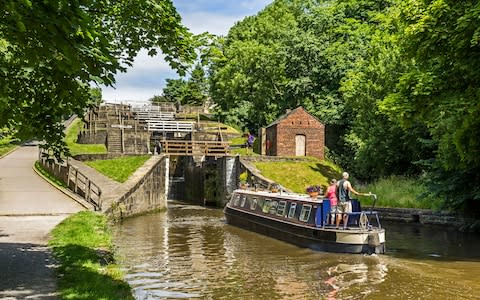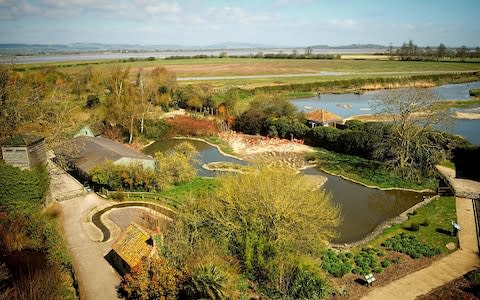From gongoozling to gastropubs – the hidden secrets of Britain's waterways

For ten years I’ve lived aboard my narrowboat, cruising the 2,000 miles of waterways in Britain. I’ve travelled the length of the joined navigable canals and rivers, from Tewitfield, near the Cumbrian border, to Godalming in Surrey.
Every few days I move my boat-home to a new mooring spot with a fresh view. Preferably it’s a scene with no houses or roads. I am a nomad of the waterways. My boat rocks gently as I walk around. Reflections of sunlight on water play across the ceiling. There is birdsong from hedgerows. Swans appear at my window. And then I cruise on again, through locks and cuttings, under arched bridges, beside flowery towpaths where horses once towed cargo boats laden with coal and pottery, manure and limestone.
Warehouses, pottery kilns and factories still line the canal, some in ruins, others converted into apartment blocks. Residents wave from balconies as I pass below. I still have much to explore but I’ve seen hundreds of miles and travelled through countless locks over the years. Here are some of my favourite places – and some are a little secret, so don't go telling anyone.
The best for gongoozling
A ‘gongoozler’ enjoys watching canal boats. The first written use of the word dates to 1904. Prime gongoozling territory is any hill where boats ascend or descend using the power of water and 200 year old engineering. There are more than 1,500 locks on the navigable waterways so there are plenty to choose between. Great gongoozling days out include Foxton Locks in rural Leicestershire with a well-placed cafe and a museum about a former inclined plane; and Caen Hill flight in Wiltshire – 29 wide locks marching relentlessly uphill for two miles that can take a boat six hours to transit.
My personal favourite is Bingley Five Rise in Yorkshire. Five massive wide-beam locks plunge down the steepest gradient (1:5) in the UK. Each chamber is crossed by a wooden pedestrian bridge, perfect for gazing into the depths to observe the magic of the lock.

There are two working boat lifts on the inland waterways: Anderton boat lift in Cheshire and the Falkirk Wheel in Scotland. Both have visitors’ centres, cafes and trip boats.
The best gastropubs
The Bridge Inn, Ratho, on the banks of the Union Canal in Edinburgh has its own canal-side garden growing herbs and vegetables. They also keep a small herd of pigs, so food miles are minimal for some menu items. This award-winning inn has four bedrooms decorated in a classic, clean style. Dinner, bed and breakfast packages start at a very reasonable £125 for two people.
In England meanwhile, The Trout Inn, on a small weir arm of the River Thames in Oxford, is all 17th century Cotswold stone with orange lichen. Inside there are fireplaces and sleek furniture. Outside, right next to the river, there’s a terrace with square canvas umbrellas. The Trout Inn successfully marries cosy with stylish and the food’s good too.

The best wildlife
Slimbridge Wetland Centre is famed for its bird hides from which you can spot overwintering Bewick swans, avocets and more (£13.45 adult, £7.90 child). The centre is a short walk from the Gloucester & Sharpness canal. Plenty of twitchers avoid the entrance fees and spot birds for free from the towpath, setting up their scopes next to the canal, peering across meadows and wetlands to the wide, glittering Severn estuary. You may be lucky and see a marsh harrier or a bean goose.
Another waterway, the nine-mile long, semi-navigable Pocklington Canal in Yorkshire, is also brilliant for wildlife with at least 13 species of dragonflies and damselflies, rare water plants, otters and wetland birds. No wonder it’s designated as a Site of Special Scientific Interest.
The best extreme boating experience
Despite narrowboats’ flat bottoms, designed for inland waters, each year a few daredevils cruise down an estuary out to sea and at least one narrowboat has cruised across the English Channel. Such hair-raising adventures are not possible for holiday boaters. However, there is a more accessible adrenaline-pumping experience: a three-mile long unlit tunnel.

Standedge tunnel burrows under the Pennine Hills, at an altitude of 643ft. It’s the longest, highest and deepest navigable canal tunnel in the world. If you’re on a hire boat, you will be accompanied by a chaperone from Canal & River Trust who provide you with hard hats and other safety equipment. For those without a boat of their own, there are organised trips from Marsden or Diggle between April and October. Some tours include a guided walk over the top.
The best aqueduct
Telford’s Pontcysyllte aqueduct is deservedly the most photographed. Dubbed ‘a stream in the sky’, the canal, in a narrow iron trough over 1,000ft long, traverses the River Dee, over 120ft below.
England’s longest similar cast iron aqueduct is 475ft long Edstone in Warwickshire. When I cruised across, a steam train passed below us, cloaking us in steam and smuts. Perfect timing.

But if pressed, my favourite aqueduct has to be the splendid Lune aqueduct, north of Lancaster. This fabulous Georgian structure by Rennie spans 664ft across the valley, with the River Lune 53ft below. It was built on the foundations of Russian timber sunk deep into the river’s bed.
The best for dogs
The square kilometre of the Ordnance Survey map containing more public rights of way than any other in the UK is in West Yorkshire. The Rochdale Canal passes through the square, near the Calderdale town of Hebden Bridge, famed for organic cafes and crystals, mkaing it perfect for dog walkers. There are beautiful circular walks along the canal, up farm lanes and woodland footpaths to the moors, to Stoodley Pike for views then back down to town where Hebden Bridge’s Lamppost Cafe was designed with dogs in mind.
For flatter walking territory, Surrey’s Wey navigation is especially lovely, with an unusual turf-sided lock on the canal, pale ruins of Newark priory, Papercourt Meadow where cows drink from the meandering river and a footpath right through the centre of Wisley RHS garden.

